ON THE TRAIL OF E A BOWLES – SLOWING DOWN MY THINKING ABOUT CROCUS AND OTHER SPRING BULBS
 The silvery outer petals of not-yet-open Crocus tommasinianus, my front garden.
The silvery outer petals of not-yet-open Crocus tommasinianus, my front garden.
 Radiant silvery-mauve Crocus tommasinianus displaying their rich orange stamen in the sunshine.
Radiant silvery-mauve Crocus tommasinianus displaying their rich orange stamen in the sunshine.
My relationship with crocus has, up until now, been a simple one. I have loved the gentle reliability of the silvery-mauve Crocus tommasinianus and as a garden designer I have often used it as the first to flower in a bulb programme for clients’ gardens. It works well planted generously (they are not expensive) to form an undulating ribbon to quietly light up a border in February. It is also wonderfully effective in grass. In my own front garden I have planted a semi circle around a multi stemmed magnolia tree. I love the way the crocus foliage emerges suddenly each year from the expanse of lawn, at first offering an almost ghostly silvery sweep and then, on the first really sunny day, socking it to the street, an uplifting arc of rich purple which literally stops passers-by in their tracks.
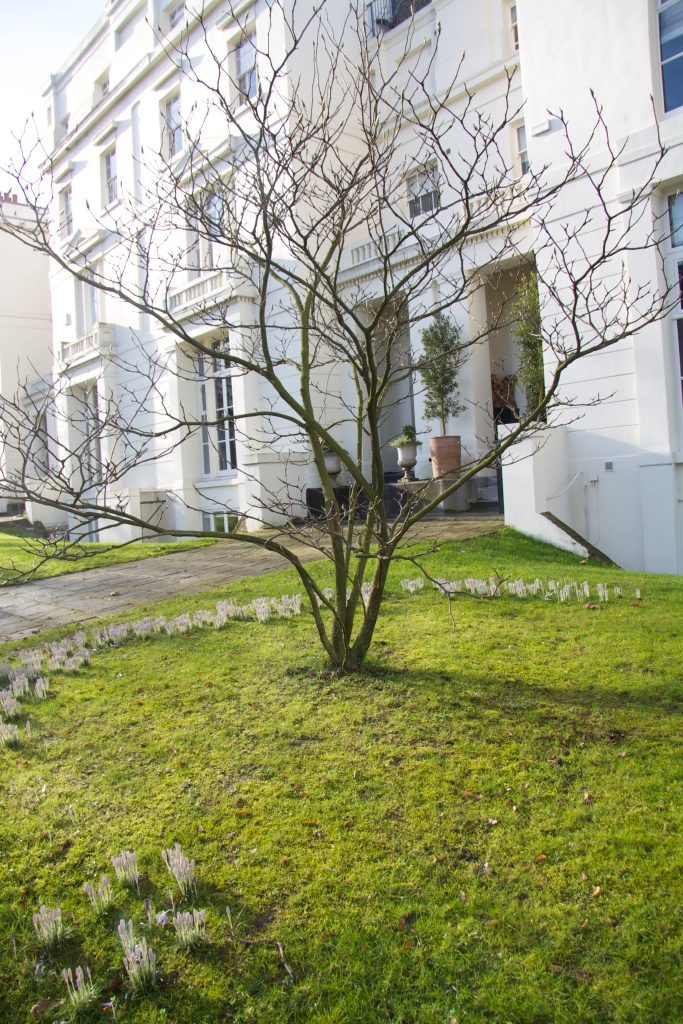 The closed crocus form a discreet ordered semi circle.
The closed crocus form a discreet ordered semi circle.
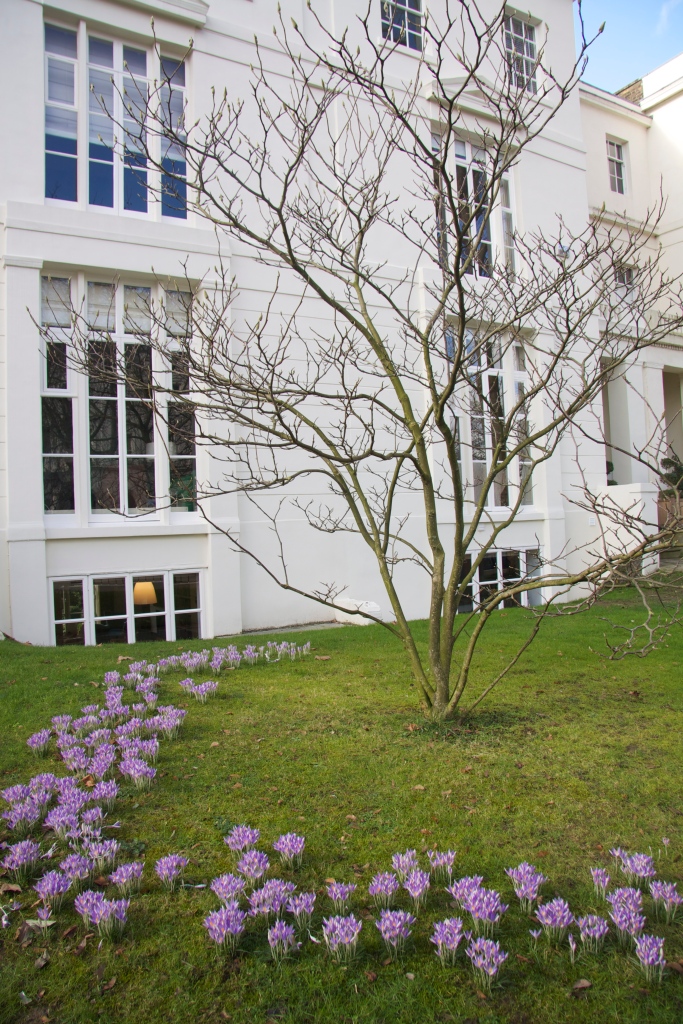 For a week or two the open crocus become an eye-catching swathe of purple.
For a week or two the open crocus become an eye-catching swathe of purple.
Contrary to popular myth my semi circle was not intended to form a ‘C’ (the initial of my family surname) but I do have a friend whose husband planted her initial – ‘O’ – in Crocus tommasinianus in the lawn one autumn as a complete surprise for her. If the weather works in your favour the crocus should be in flower on Valentine’s Day so a romantic gesture to try perhaps this autumn?
Earlier this week I found myself heading, initially rather unpromisingly, to Enfield, North London, to find out more about one of the twentieth century’s great gardeners – and ‘Crocus King’ – E A Bowles (1865-1954).

 Turkey Street Enfield – en route to Myddelton House.
Turkey Street Enfield – en route to Myddelton House.
It is hard to imagine now what it must have been like to arrive at Bowles’ home, Myddelton House, in the late 19th and early 20th century, but on March 1st 2017 it was a relief to get away from the network of subways leading from a lonely section of Ginger Line and arrive at the imposing early 19th house where the eminent plantsman spent so many years growing studying, painting and writing about plants.

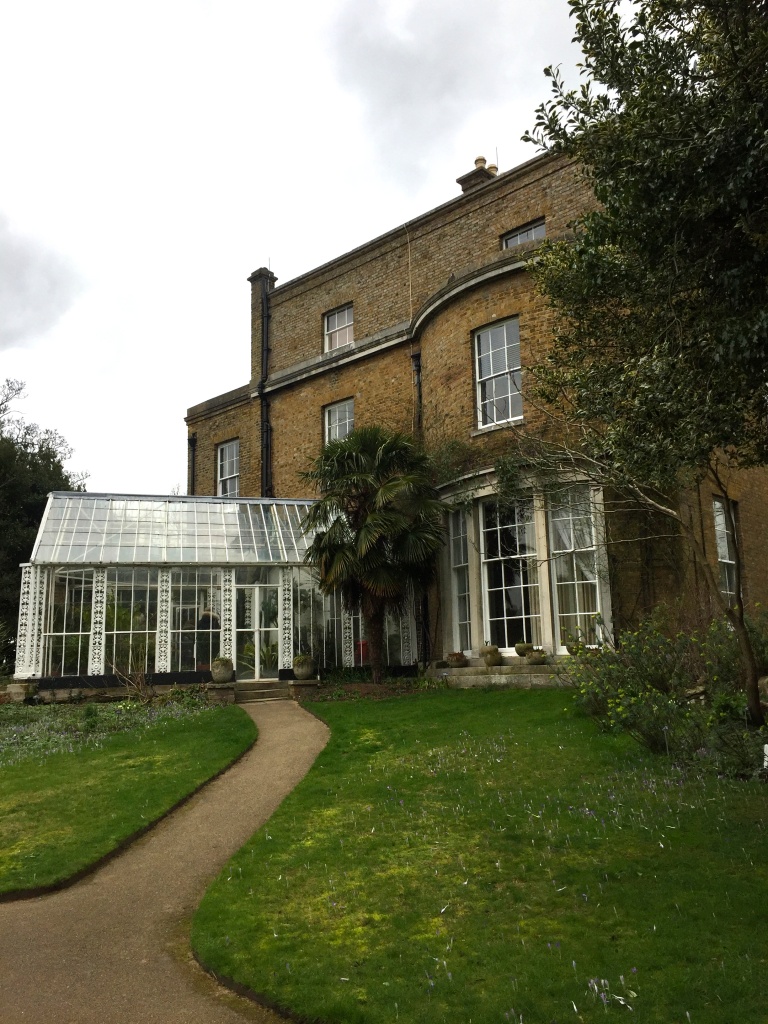 Myddelton House
Myddelton House
In 1914 Bowles wrote ‘My Garden in Spring’ based on his personal and passionate observations of the garden around the family home. He gardened here with tireless experimentation despite his frustration at the growing conditions: “the climate, soil and trees contrive to make it the driest and hungriest in Great Britain”. ‘My Garden in Spring’ was followed by ‘My Garden in Summer’ (also published in 1914) and ‘My Garden in Autumn and WInter’ (1915). These became best sellers, regularly reprinted, and were followed by ‘A Handbook of Crocus and Colchicum’ (1924) and ‘A Handbook of Narcissus (1934), both leading studies of their day.
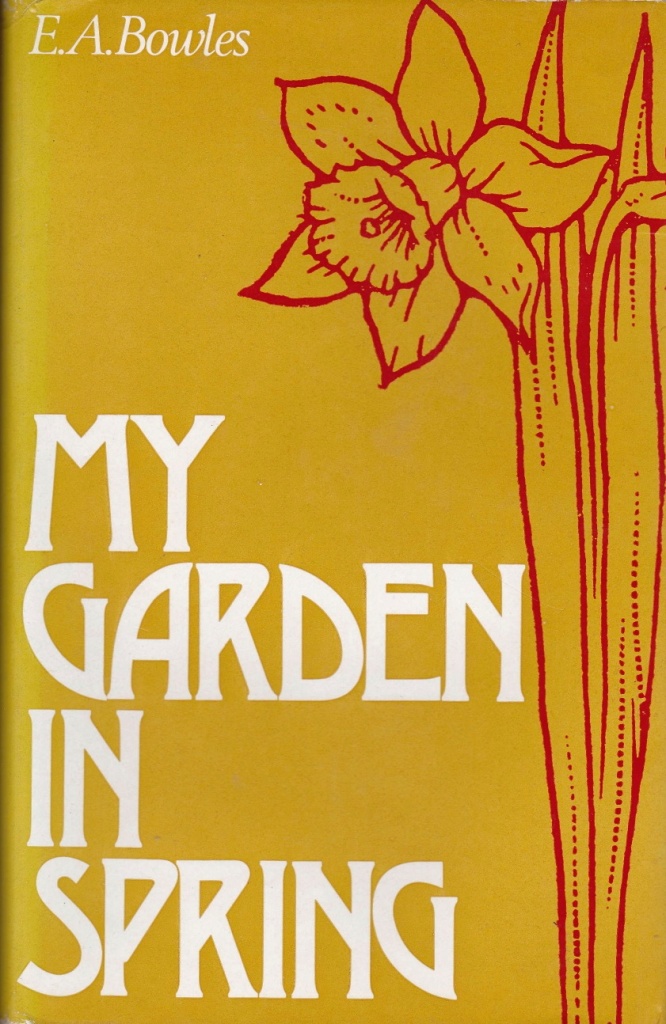 My 1972 edition of ‘My Garden in Spring’.
My 1972 edition of ‘My Garden in Spring’.
Bowles befriended the great plant hunters of the time – including the legendary Reginald Farrer who wrote a feisty introduction to ‘My Garden in Spring’ – made hundreds of drawings and painting of plants (many now held at the RHS Lindley Library) and nurtured fine cultivars of a wide range of plants, many of which still bear his name today. These include the richly coloured – and edible – Viola ‘Bowles’s Black’, Carex elata ‘Aurea’ or Bowles’ Golden Sedge – a wonderful evergreen grass that lights up the darkest corner and Vinca minor ‘La Grave’ or ‘Bowles’ Variety’ – a fantastic ground cover plant, less invasive than Vinca major, smothered in lavender blue flowers from April to September. With typical charm, Vinca ‘Bowles’ Variety’ was spotted in a French churchyard en route to a plant hunting trip to the Alps.
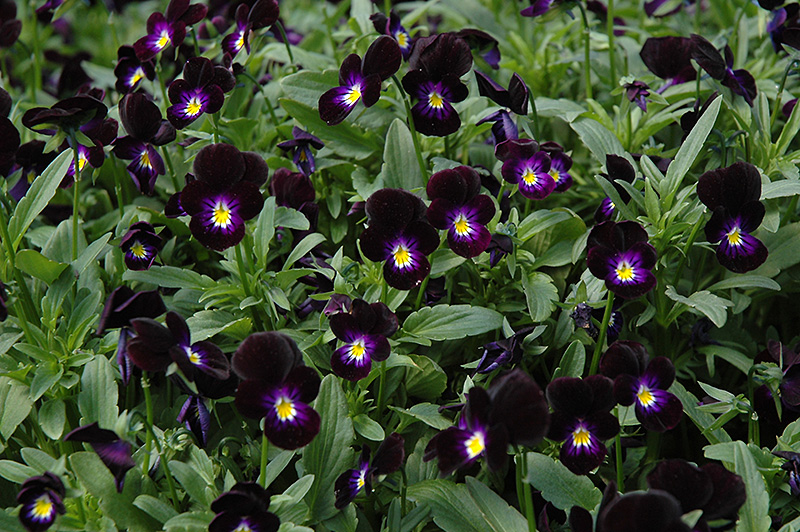 The richly coloured – and edible – Viola ‘Bowles’s Black’.
The richly coloured – and edible – Viola ‘Bowles’s Black’.

Carex elata ‘Aurea’ or Bowles’ Golden Sedge – a wonderful evergreen grass that lights up the darkest corner.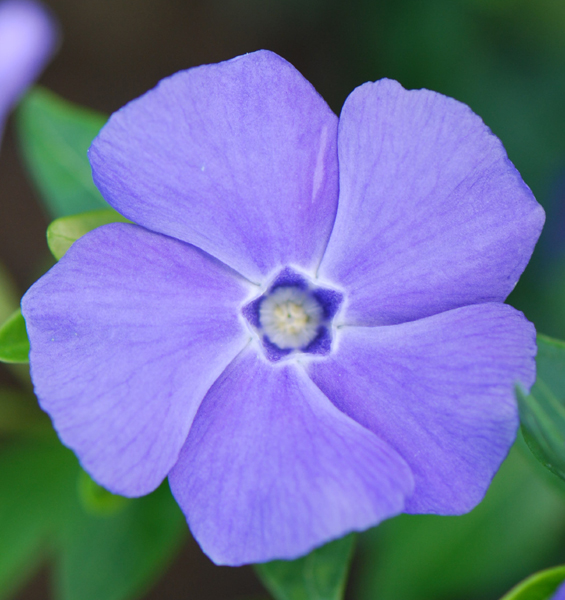 Vinca minor ‘La Grave’ or ‘Bowles’ Variety’ – a fantastic ground cover plant, less invasive than Vinca major, smothered in lavender blue flowers in from April to September.
Vinca minor ‘La Grave’ or ‘Bowles’ Variety’ – a fantastic ground cover plant, less invasive than Vinca major, smothered in lavender blue flowers in from April to September.
‘My Garden in Spring’ has a gentle honesty that feels refreshing despite its age. ‘Many find the garden too museumy to please them’ he sets out frankly near the beginning of the book and there are some spectacularly ponderous diversions such as the following saga on the elusive definition of spring: ‘a large number of people over a certain age would insist that Spring no longer exists, and would probably endeavour to prove this assertion by lengthy reminiscences of halcyon days of yore, which provided early opportunities for picnics and thin raiment. Who has not heard their Great-Aunt Georgina hold forth on the Indian muslins that in bygone Mays were all-sufficient for her comfort…’
But it does not take long for the reader to be caught up in Bowles’ enthusiasm and enormous attention to detail. Here his description of Crocus balansae gives a taste of the depth of his passion:

Crocus olivieri ssp. balansae ‘Zwanenberg’ – photo courtesy of specialist Alpine nursery Potterton’s.
‘Crocus balansae … has three outer segments externally of a deep mahogany colour, and in bud looks nearly black and is very hard to see, but the moment these deep-coloured segments part, the rich orange of the inner segments makes a most conspicuous and beautiful object of the flower … Everyone who sees it for the first time is astonished at its beauty, and can hardly believe it is real, like the little girl at the Zoo, who after gazing at the Anteaters said, ” But there aren’t really such animals as those, are there, Nurse.”‘
Bowles can be as furiously dismissive of certain crocus as he is enthusiastic about others. ‘I do not care so much for large clumps of any white form. At the back of the borders they look too cold, and suggest unmelted snow pats’ or, of Crocus graveolens, ‘one little yellow crocus has an obnoxious trait in its character and is a little stinking beast, as Dr Johnson defined the stoat’. But mostly he just wants to explain why ‘every garden ought to have large clumps of (yellow) crocus to brighten up the bare soil in February’ or the charms of his favourite Crocus chrysanthus ‘I greatly admire a gourd-shaped crocus; it means that the throat is wide and full, and the segments ample and rounded … so that an unopened blossom has a distance waist about two-thirds of the way down … when fully expanded the segments bend outwards from above this waist, forming a round rather than starry flower.’
I am beginning to look at the crocus with different eyes. ‘We treat Crocuses au grand sérieux in this garden, giving over two double-light frames to their service in the very sunniest part of the kitchen garden’ writes Bowles at the beginning of his chapter on the genus. It is these frames, re-introduced to the garden at Myddelton House by the hard-working E A Bowles Society, that I have come to see with the London group of the conservation charity, Plant Heritage.
Walking into the same ordered kitchen garden – extensively restored since 2009 with money from the Heritage Lottery Fund – and peaking into the steeply slanting Peach House with its immaculately fan-trained peaches pink with blossom, I feel a pang of desire when I arrive at the jewel box National Collection of Crocus, each in its individual pot embedded in sand.
 The Peach House with fan-trained peaches in full blossom.
The Peach House with fan-trained peaches in full blossom.

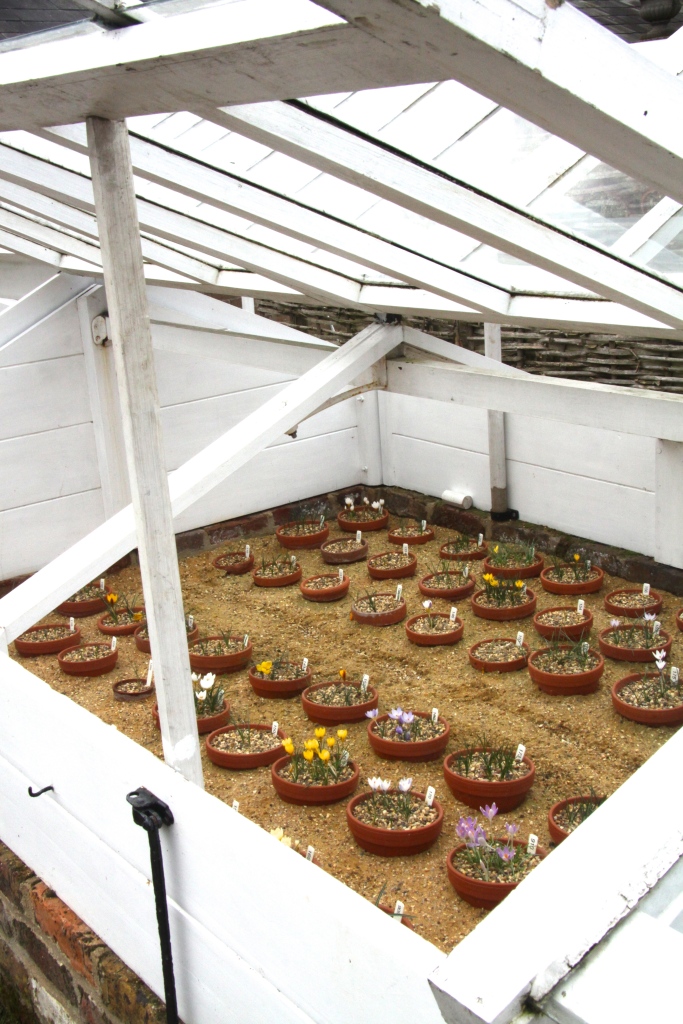

 The fleet of stilted cold frames containing the E A Bowles Society National Collection of Crocus cultivars.
The fleet of stilted cold frames containing the E A Bowles Society National Collection of Crocus cultivars.
Liz MacNicol is the splendidly named Crocus Co-ordinator at Myddelton House (NB this is a Plant Heritage job title – extreme general enthusiasts go under the banner of ‘Croconut’). A National Collection is defined as a collection of at least 75% of available cultivars and, in the case of the E A Bowles Society collection, cultivars includes all those bred by E A Bowles and still known to be in existence. Infuriatingly the yellow Crocus chyrsanthus E A Bowles seems to have disappeared altogether – although there have been hopeful sightings as reported by John Grimshaw in 2010.
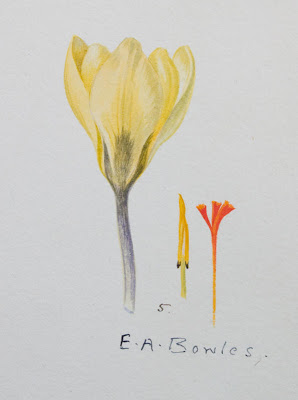
Painting by E A Bowles of Crocus chysanthus ‘E A Bowles’ courtesy of John Grimshaw’s Garden Diary
The Myddelton House Crocus Collection is painstakingly monitored at every stage of growth. Watering begins in January and carries on weekly until the leaves have died down. The crocus are fed Phostrogen every fortnight during the same period and deadheaded weekly so that the plants do not set seed (with the obvious danger of cross fertilisation). This year everything was very late because of the cold spell in January. Liz was convinced there would be precious losses as ‘there was no green at all’ in the second week of January, but in fact the cool but steady early spring that has followed seems to be bringing about a satisfyingly long display. I am surprised and then saddened that the crocus are not labelled and only numbered for security reasons, but perhaps the advantage of no name is that you look even harder at the tiny differences in shade and delicate marking of the pots of crocus on display.
Of course there is no harm in a little light guesswork. This gorgeous, singing pink, starry-flowered crocus is probably Crocus tommasinianus ‘Roseus’ described by the specialist nursery Potterton’s as ‘an outstanding and justifiably popular form with numerous large, bright rose-pink flowers, that are silvery-grey outside’.
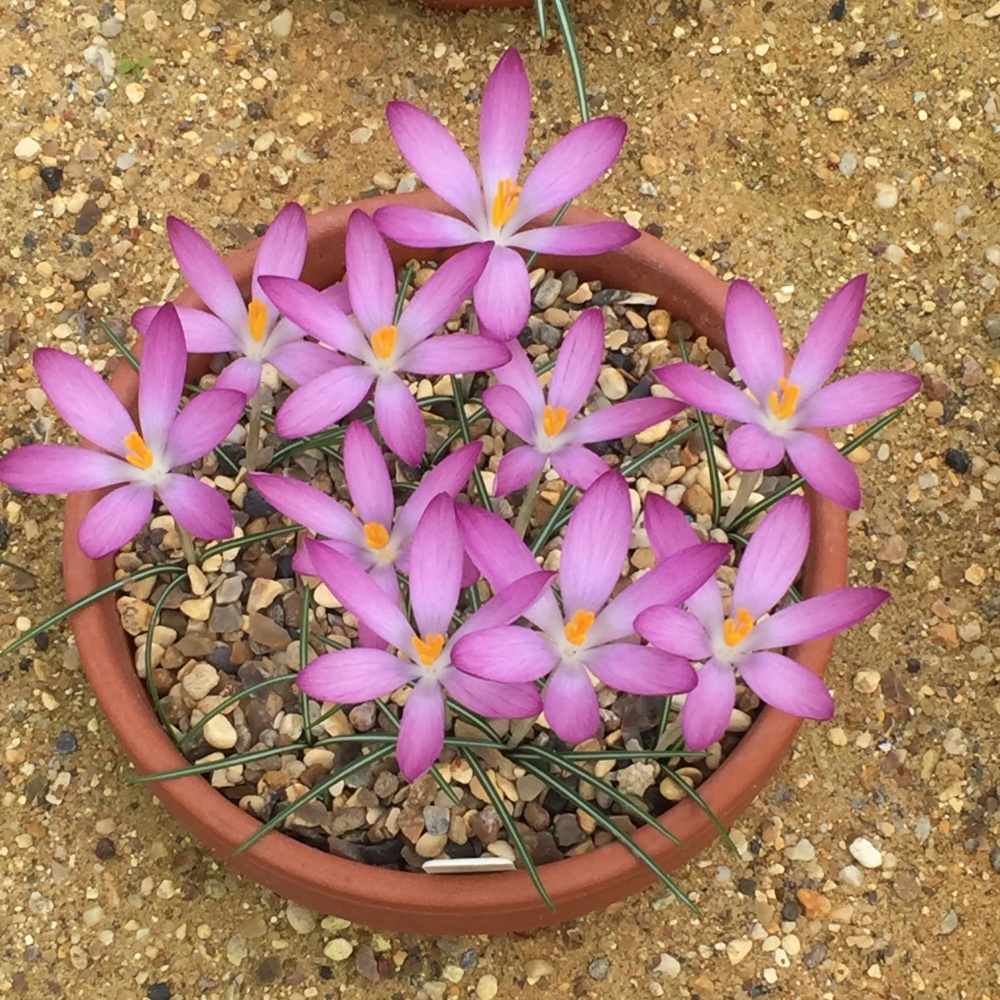 Possibly Crocus tommasinianus ‘Roseus’.
Possibly Crocus tommasinianus ‘Roseus’.
And this is possibly Crocus chrysanthus ‘Snow Bunting’ which Potterton’s Nursery describes as ‘…ivory with a faint purple blush on the outside of the petals. It has a delicate musky scent and bright yellow orangey anthers and has received the RHS Award of Garden Merit.’ 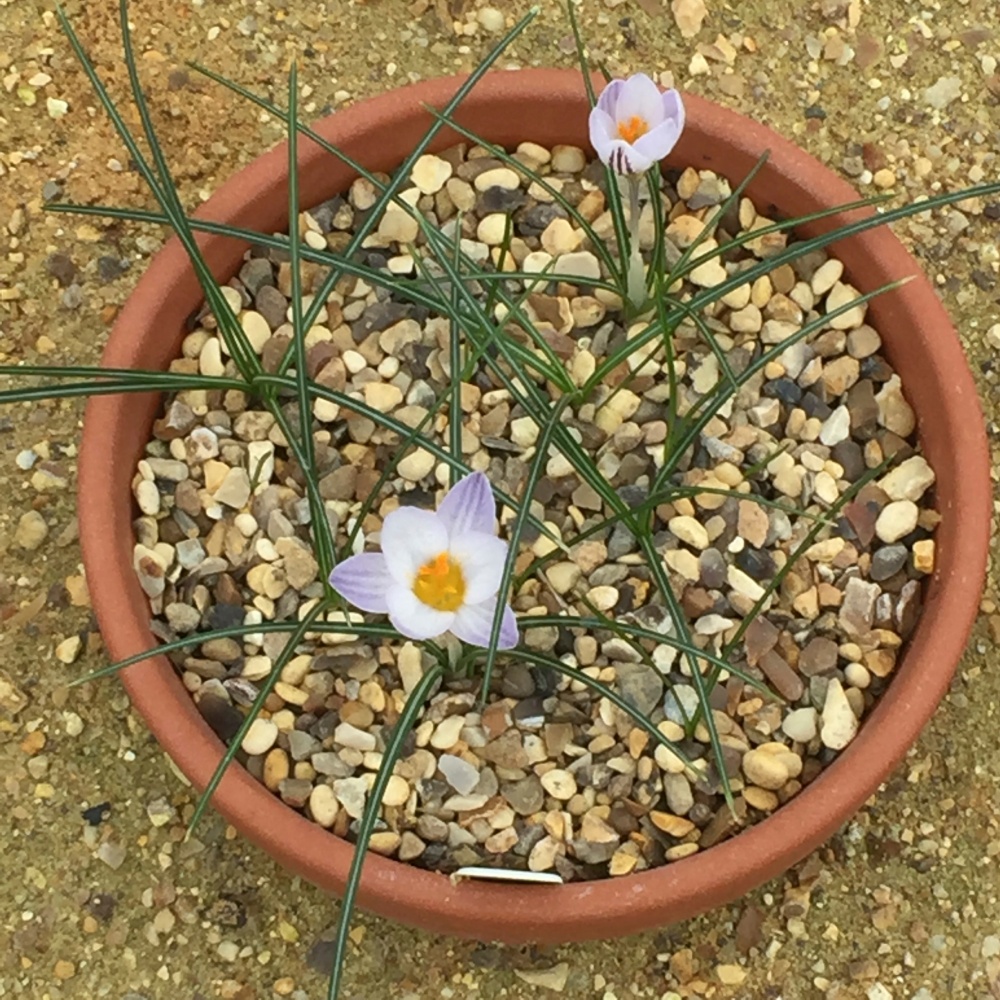
The wonderfully delicate ‘Snow Bunting’ is the only crocus bred by E A Bowles still commercially available. It naturalises happily and is absolutely one for my autumn list:

Crocus ‘Snow Bunting’ – photograph © the E A Bowles Society.
As I read up about the finely marked, washed lavender ‘Blue Pearl’ – often one of the earliest crocus to emerge and surprisingly tough and long lasting in grass – and the vibrant purple feathering on the pale yellow fragrant ‘Gypsy Girl’, I realise that my list of desirable (and happily readily available) crocus is growing longer and longer.
 Crocus biflorus ‘Blue Pearl’ – photograph © the E A Bowles Society.
Crocus biflorus ‘Blue Pearl’ – photograph © the E A Bowles Society.

Crocus ‘Gypsy Girl’ – photograph © the E A Bowles Society.
Other crocus are extremely rare, surviving only by being nurtured in this careful way and should be enjoyed for the short time they are in flower. The Myddelton House Collection contains such treasures as the slow-to-reproduce and the graceful Crocus ‘Kittiwake’ (Bowles named a whole series of crocus after birds, one of his other great interests), and Crocus tommasinianus ‘Bobbo’ named ‘to remind me of the sharp-eyed boy who was the first to spot it’.

Crocus ‘Kittiwake’ – photograph © the E A Bowles Society.
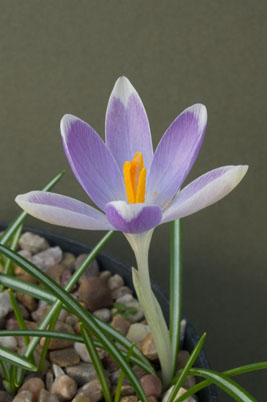 Crocus tommasinianus ‘Bobbo’ – Crocus © the E A Bowles society.
Crocus tommasinianus ‘Bobbo’ – Crocus © the E A Bowles society.
Beyond the cold frames at Myddelton House, Bowles encouraged Crocus tommasinianus to form generous uplifting drifts along with snowdrops. He would be constantly on the look out for unusual crocus which he would select and grow on. So now, as well as being able to choose a particular shade – a darker purple or a more rosy hue perhaps – there are opportunities to extend the period of colour by planting bulbs which flower in succession.

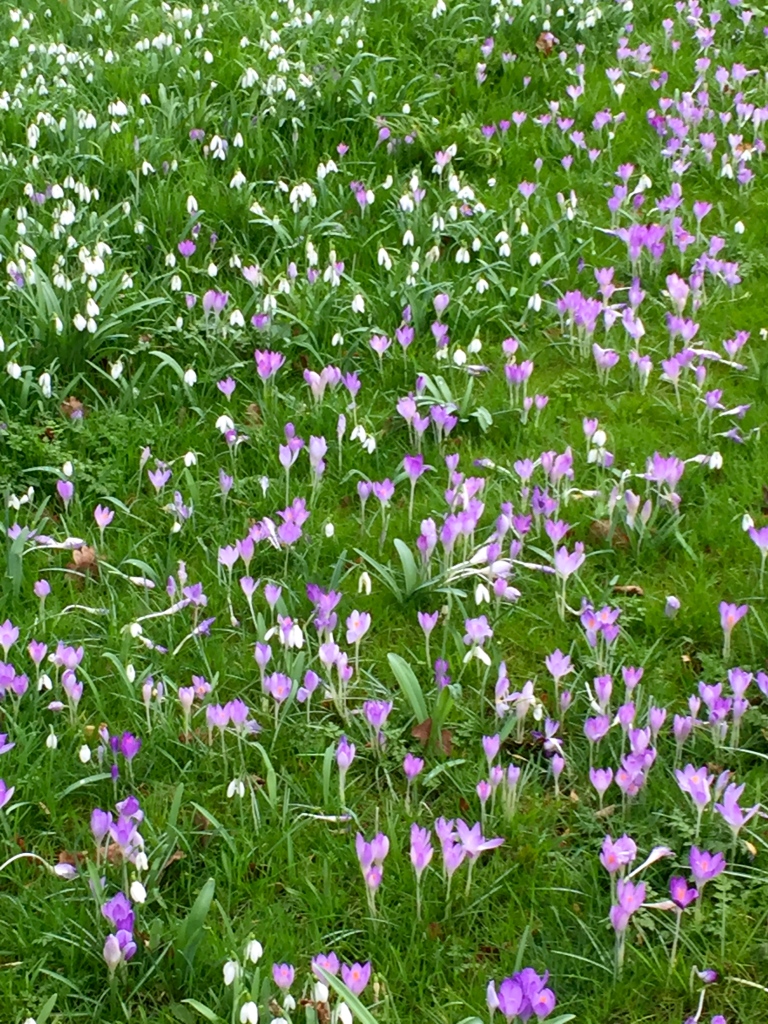
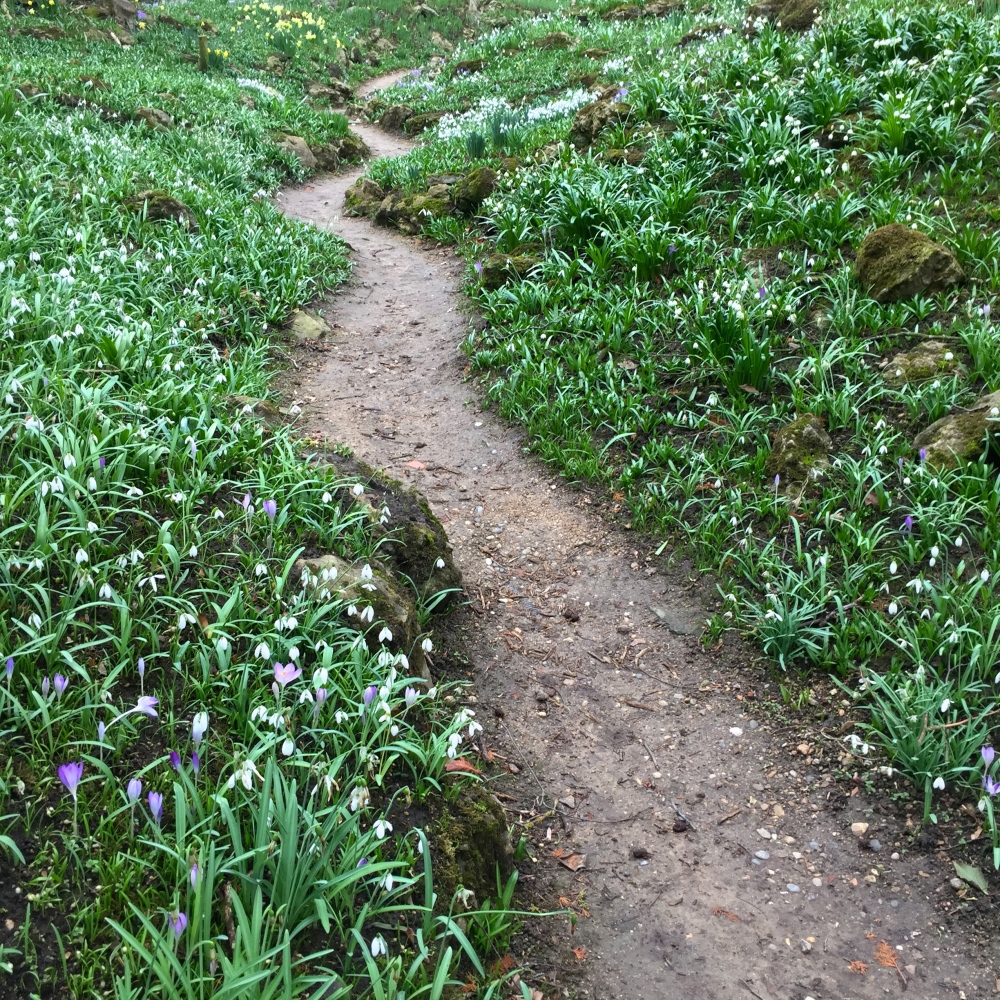 Huge numbers of Crocus tommasinianus and snowdrops in the Alpine Meadow and Rock Garden at Myddelton House.
Huge numbers of Crocus tommasinianus and snowdrops in the Alpine Meadow and Rock Garden at Myddelton House.
I find myself turning again to Anna Pavord’s wonderful book ‘Bulb’ (published in 2009, so a mere sprig in horticultural book years) to find out more. ‘Bulb’ was the result of season after season of growing every kind of bulb and taking the trouble to observe them closely and to appreciate both finer and irritating qualities. It is written in her usual seductive style which is both learned and personal and by the end I am dangerously resolved to grow entire table-fulls of bulbs in pots next year, as well as to attend to the question of succession in my own front garden.
 BULB by Anna Pavord.
BULB by Anna Pavord.
A wise sequence of Crocus tommasinianus could well be the mid February flowering ‘Whitewell Purple’ (‘the stigma is brilliant orange, the stamens paler, though you need sun to see the beauty of the inside, when the flower opens flat like a spreadeagled sunbather’), ‘Barr’s Purple’, named after the great Victorian nurseryman Peter Barr, and finally the late February ‘Ruby Giant’ which, as Ms Pavord wryly observes, is ‘neither ruby, nor a giant, it is a beautiful crocus, the three outer petals faintly stippled with paler streaks’.
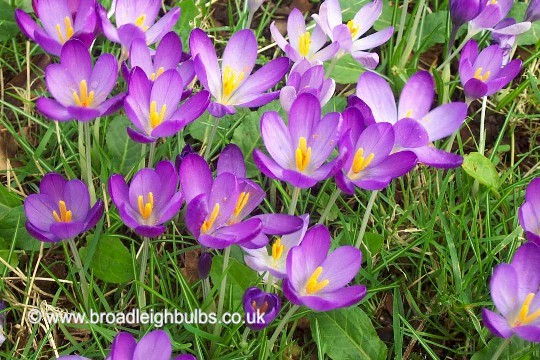 Crocus tommasinianus ‘Whitewell Purple’ – photograph © Broadleigh Bulbs.
Crocus tommasinianus ‘Whitewell Purple’ – photograph © Broadleigh Bulbs.
 Crocus ‘Barr’s Purple’ – photograph © Potterton’s Nursery.
Crocus ‘Barr’s Purple’ – photograph © Potterton’s Nursery.
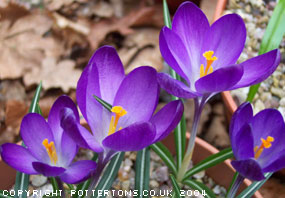 Crocus tommasinianus ‘Ruby Giant’ – photograph © Potterton’s Nursery.
Crocus tommasinianus ‘Ruby Giant’ – photograph © Potterton’s Nursery.
Mulling this over – how many of each to order to top up my existing Crocus tommasinianus? – I step out of the Kitchen Garden into a series of glass houses. These are furnished with families of colourful exotic plants and have the friendly, storytelling quality of a Henri Rousseau painting.
 Glass House next to the Kitchen Garden.
Glass House next to the Kitchen Garden.
My favourite is a glass conservatory built onto the house itself. I love the chequered floor tiles, the white painted, curly Victorian ironwork and inside a little world of shocking pink flowers, skinny, emerald green cactus and a louche flowering Aeonium in an old lead water tank. Perhaps because of the curiousness of the collection, and the proximity to the house, there is a feeling of pure excitement in the conservatory that brings us a little closer to the great man himself. 

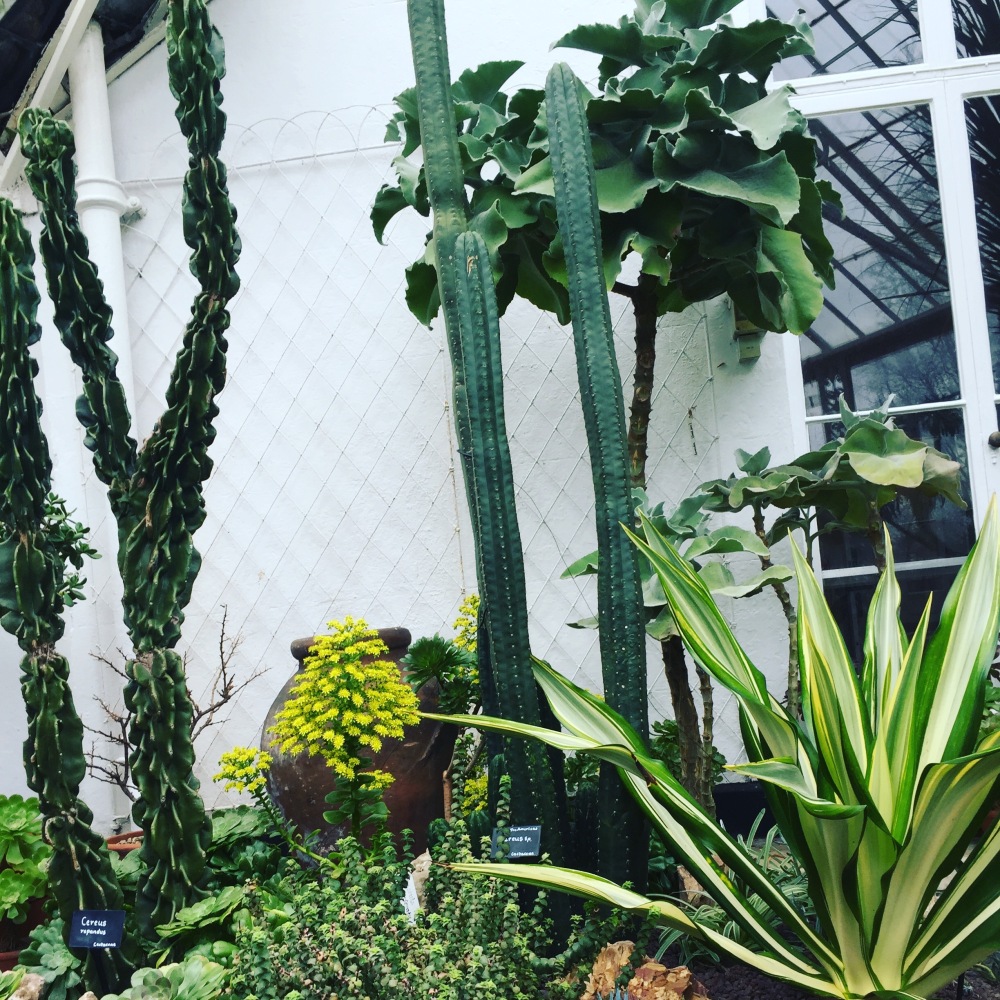 Conservatory, Myddelton House
Conservatory, Myddelton House
I speed back into town where I am to meet Andrea Brunsendorf, the talented and exacting Head Gardener of the Inner Temple Gardens – the constantly surprising three acres of garden surrounded by Barristers’ chambers between Temple and Blackfriars stations. I wrote about the gardens in their full September glory in my The Dahlia Papers post SECRET LONDON BENCHES.
I have already heard about Andrea’s frustration with the damage a group of six or seven pigeons, a mixture of wood and street pigeons, are inflicting year after year on the south facing bank where she has tried everything she can to achieve something even close to a sheet of crocus. She explains that her lack of success is particularly galling as she trained at Kew which is famous for its huge spreading seas of pale purple and white at this time of year and yet all she has to show on March 1st are these sporadic dark purple clumps of ‘Ruby Giant’ (remember Anna Pavord’s wise words : ‘Ruby Gian’ is neither ruby, nor giant’).
 Crocus tommasinianus ‘Ruby Giant’ on the south facing bank – The Meadow – at Inner Temple Gardens.
Crocus tommasinianus ‘Ruby Giant’ on the south facing bank – The Meadow – at Inner Temple Gardens.

Beheaded clumps of Crocus tommasinianus ‘Ruby Giant’, Inner Temple Gardens.
Pigeons are well known for attacking yellow crocus, and some gardeners will avoid yellow ones completely, but Andrea has used only purple and white cultivars, and has done everything by the book: successional planting of different crocuses in an open sunny spot, starting off with several hundred in each section and then adding perhaps 150 new bulbs each year; she has employed fake birds of prey; real hawks (‘the hawks came on Wednesdays and the pigeons just came back on the Thursday’); and one year she went for the full allotment style CD’s dancing in the wind. We discuss other possible crocuses – Sarah Raven’s favourite crocus is Crocus chrysanthus ‘Spring Beauty’ which she regards as super tough as well as exquisite with deep purple feathering on pale mauve and Dan Pearson had success in his London garden with Crocus tommasinianus ‘Lilac Beauty’ – one that Andrea has not in fact tried. Andrea notes these down with wistful enthusiasm and then her face lights up with a fanciful idea of sourcing hundreds of yellow windmills – the kind children play with at the seaside – and planting them in droves amongst the crocus… There have been better years: ‘once we had not cleared the Persicaria orientalis on the borders immediately above the meadow so there was a great alternative food source nearby which seemed to make a difference.’ But it is an incredibly difficult thing to experiment with scientific precision when you are caring for a garden that has to look good throughout the year.
In the end Andrea thinks she will have to look to other plants to accompany the crocus – scillas probably (although they are ‘disappointingly pale’), or the rich gold and mahogany coloured Primula ‘Gold Lace’.
 Primula ‘Goldlace’ amongst emerging Smirnium perfoliatum elsewhere in the garden.
Primula ‘Goldlace’ amongst emerging Smirnium perfoliatum elsewhere in the garden.
The Inner Temple Garden is open to the public during the week at lunch time. There are rare trees and shrubs, amazing displays of tulips and the herbaceous borders are an extraordinary contrast to the manifestly serious buildings which surround them. It is worth visiting at absolutely any time of year. What is more, Andrea Brunsendorf’s quarterly column on her work in the garden, Garden News, is full of inspiring and generous observations.
When I visited a few days ago I was smitten by this gorgeous, weeping Acacia pravissima – a small elegant evergreen tree about to burst into yellow, fragrant flower and by the low mounding cushions of Coronilla valentina subsp. glauca ‘Citrina’ softening the central stone steps and again on the verge of opening into scented, paler yellow flower:
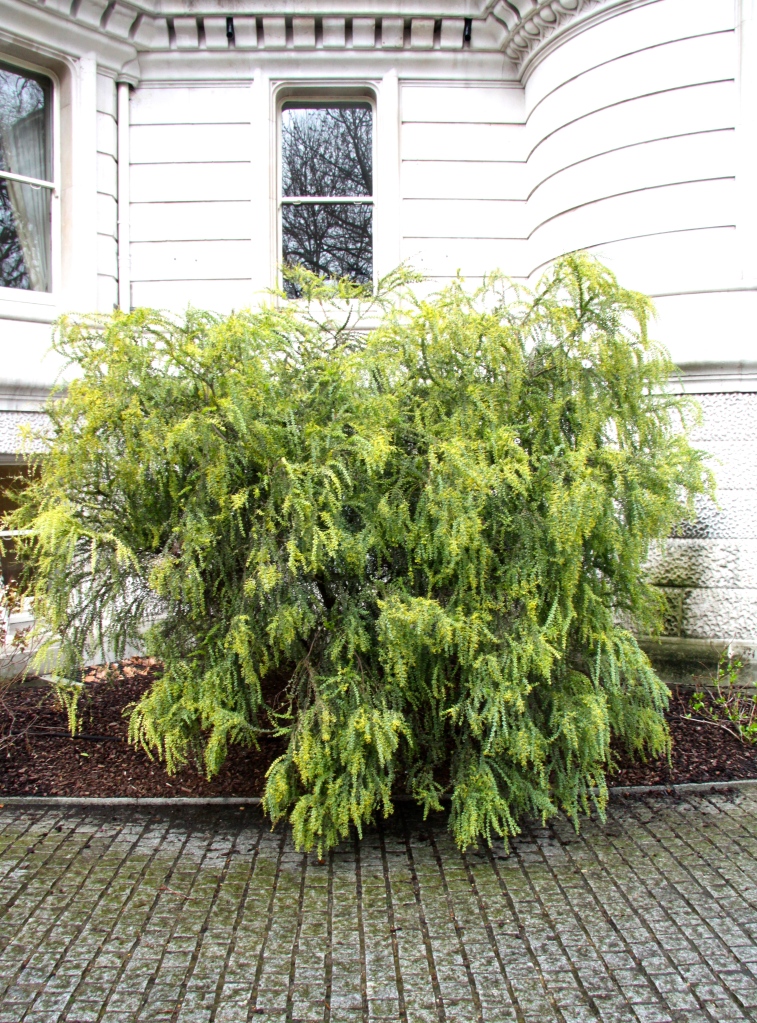
 Acacia pravissima
Acacia pravissima

 Coronilla valentina subsp. ‘Citrina’.
Coronilla valentina subsp. ‘Citrina’.
As we are saying goodbye, Andrea has an idea. Looking across at the Iris unguicularis that are thriving on the same bank, nestling amongst lush mediterranean planting, she suddenly wonders if she could use mounds of this ‘Algerian Iris’ on the challenging south facing bank. Iris unguicularis is an exquisite plant which flowers over a long period from late winter to early spring and would give exciting height and bulk to the entire slope.

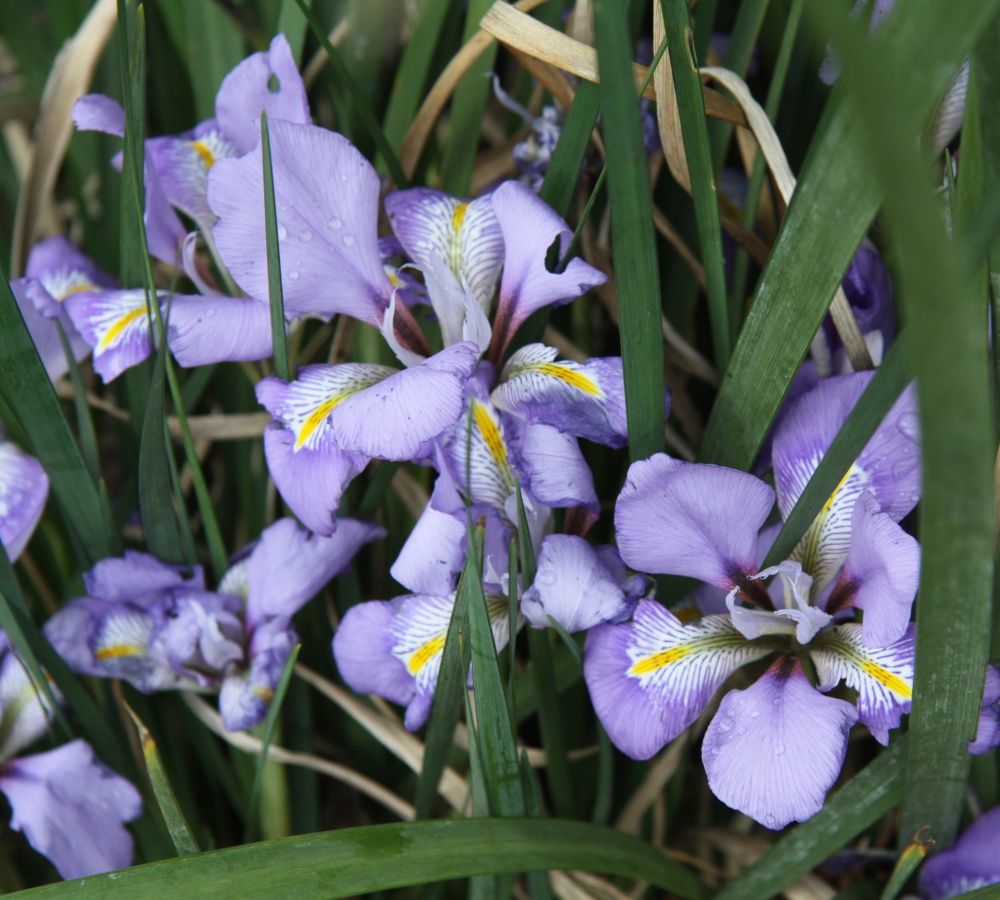 Iris unguicularis nestling amongst Mediterranean planting on the Wildflower Bank, Inner Temple Gardens.
Iris unguicularis nestling amongst Mediterranean planting on the Wildflower Bank, Inner Temple Gardens.
Extraordinarily, E A Bowles writes in ‘My Garden in Spring’ ‘Suppose a wicked uncle who wished to check your gardening zeal left you pots of money on condition you grew on one species of plants: what would you choose? I should settle on Iris unguicularis.’ Bowles loved the plant for its ‘soft lilac colouring and crystalline texture’ and for its’ scent, ‘fuller than the scent of Primrose, with a promise of honey strong enough to wake any bee (but with a) correcting sharpness in it, like that of lemon with the sugar of a shrove Tuesday pancake’. Best of all, even for the Crocus King, it is simply ‘the first flower of spring’.
Andrea worries for a moment what would happen to the Iris unguicularis when, later in the year, she mows the entire bank. How would Iris unguicularis react to that? ‘Well, you are not supposed to cut Kniphofia to the ground but I do it and it comes back …’.
I suspect a wonderful solution has been found.
